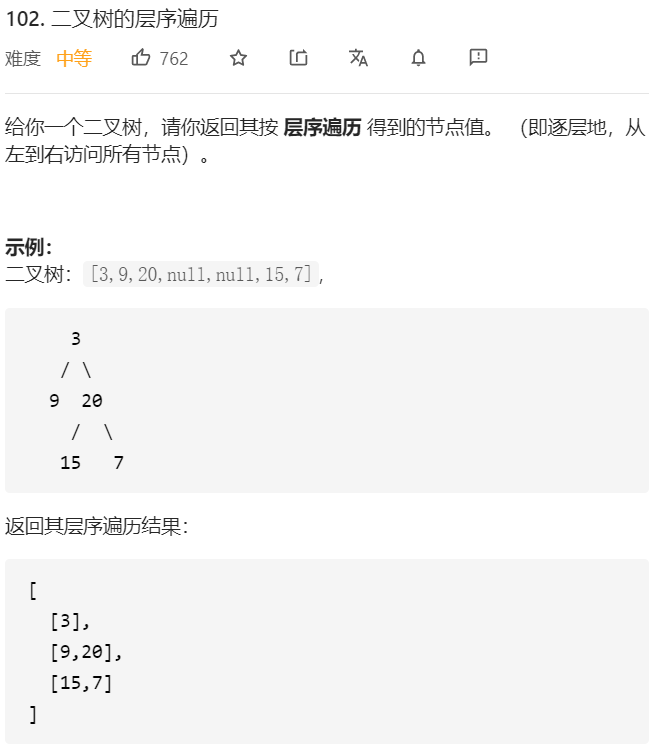本文主要是介绍【LeetCode102】逐层输出二叉树(层次遍历),希望对大家解决编程问题提供一定的参考价值,需要的开发者们随着小编来一起学习吧!
1.题目

2.思路
层次遍历:借助队列,先将根结点入队,然后循环出队首结点,并且将该结点的左子树和右子树加入队列中。
(1)题目要求输出每层的结点,而常规模板中的队列是各层结点混在一起的,所以为了区分每层,在原本模板的while里面加了个for循环——该for循环即将一层的结点存入layer数组中,之所以for的遍历次数即改层的结点个数width确定,是因为在进入for前的队列长度即为该层的结点个数。
(2)队列中存放的是node*型,而非node型——否则当需要修改队首元素时,就无法对原元素进行修改(只是修改了队列中的副本);当然如果是使用静态二叉链表存树的写法,队列就是queue<int>q了。
(3)由于可能一开始为空树,所以需要判空,即若为空则返回二维数组ans,注意看清返回值,而非返回NULL;
(4)要非常熟练树的模板。
3.代码
/*** Definition for a binary tree node.* struct TreeNode {* int val;* TreeNode *left;* TreeNode *right;* TreeNode(int x) : val(x), left(NULL), right(NULL) {}* };*/
class Solution {
public:vector<vector<int>> levelOrder(TreeNode* root) {queue<TreeNode*>q;//放指针vector<vector<int>>ans;if(!root)return ans;q.push(root);while(!q.empty()){//如果队列不空vector<int>layer;layer.clear();int width=q.size();for(int i=0;i<width;i++){//把一层的结点存入layer数组中,关键!TreeNode* temp=q.front();q.pop();layer.push_back(temp->val);if(temp->left){q.push(temp->left);}if(temp->right){q.push(temp->right);}}ans.push_back(layer);//一层完毕}return ans;}
};
在《剑指offer》中的32-I 从上到下打印二叉树,做法和这题是一样的,虽然不需要二维数组,只用一维数组,即不用多个layer数组:
/*** Definition for a binary tree node.* struct TreeNode {* int val;* TreeNode *left;* TreeNode *right;* TreeNode(int x) : val(x), left(NULL), right(NULL) {}* };*/
class Solution {
public:vector<int> levelOrder(TreeNode* root) {queue<TreeNode*>q;vector<int>ans;if(!root) return ans;q.push(root);while(!q.empty()){int width = q.size();for(int i = 0; i < width; i++){TreeNode* temp = q.front();q.pop();ans.push_back(temp->val);if(temp->left){q.push(temp->left);} if(temp->right){q.push(temp->right);}}}return ans;}
};
这篇关于【LeetCode102】逐层输出二叉树(层次遍历)的文章就介绍到这儿,希望我们推荐的文章对编程师们有所帮助!






